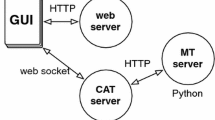Abstract
The use of Machine Translation as a tool for professional or other highly skilled translators is for the most part currently limited to postediting arrangements in which the translator invokes MT when desired and then manually cleans up the results. A theoretically promising but hitherto largely unsuccessful alternative to postediting for this application is interactive machine translation (IMT), in which the translator and MT system work in tandem. We argue that past failures to make IMT viable as a tool for skilled translators have been the result of an infelicitous mode of interaction rather than any inherent flaw in the idea. As a solution, we propose a new style of IMT in which the target text under construction serves as the medium of communication between an MT system and its user. We describe the design, implementation, and performance of an automatic word completion system for translators which is intended to demonstrate the feasibility of the proposed approach, albeit in a very rudimentary form.
Similar content being viewed by others
References
Blanchon, Hervé.: 1994, Perspectives of DBMT for Monolingual Authors on the Basis of LIDIA-1, an Implemented Mock-up, in COLING-94: The 15th International Conference on Computational Linguistics, Kyoto, pp. 115–119.
Boitet, Christian.: 1990, Towards Personal MT: General Design, Dialogue Structure, Potential Role of Speech, in COLING-90: Papers presented to the 13th International Conference on Computational Linguistics, Helsinki, Vol. 3, pp. 30–35.
Brousseau, J., C. Drouin, G. Foster, P. Isabelle, R. Kuhn, Y. Normandin, and P. Plamondon: 1995, French Speech Recognition in an Automatic Dictation System for Translators: the TransTalk Project, in Eurospeech 95, Madrid, pp. 193–196.
Brown, Peter F., Stephen A. Della Pietra, Vincent J. Della Pietra, and Robert L. Mercer: 1993, The Mathematics of Statistical Machine Translation: Parameter Estimation, Computational Linguistics 19: 263–312.
Brown, Ralf D. and Sergei Nirenburg: 1990, Human-Computer Interaction for Semantic Disambiguation, in COLING-90: Papers presented to the 13th International Conference on Computational Linguistics, Helsinki, Vol. 3, pp. 42–47.
Darragh, John J. and Ian H. Witten: 1992, The Reactive Keyboard. Cambridge University Press.
Derouault, A.-M. and B. Merialdo: 1986, Natural Language Modeling for Phoneme-to-text Transcription, IEEE Transactions on Pattern Analysis and Machine Intelligence, PAMI-8: 742–743.
Eurolang: 1995, Eurolang Optimizer, Product Description.
Frederking, Robert, Dean Grannes, Peter Cousseau, and Sergei Nirenburg: 1993, An MAT Tool and its Effectiveness, in Human Language Technology, Princeton, NJ, pp. 196–201.
IBM: 1995, IBM Translation Manager, Product Description.
Jelinek, F.: 1990, Self-organized Language Modeling for Speech Recognition, in A. Waibel and K. Lee (eds) Readings in Speech Recognition, Morgan Kaufmann: San Mateo, California, pp. 450–506.
Katz, Slava M.: 1987, Estimation of Probabilities from Sparse Data for the Language Model Component of a Speech Recognizer, IEEE Transactions on Acoustics, Speech and Signal Processing, ASSP-35: 400–401.
Kay, Martin: 1973, The MIND System, in R. Rustin (ed.) Natural Language Processing, Algorithmics Press, NY, pp. 155–188.
Kugler, M., G. Heyer, R. Kese, B. von Kleist-Retzow, and G. Winkelmann: 1991, The Translator's Workbench: An Environment for Multi-Lingual Text Processing and Translation, in Proceedings of Machine Translation Summit III. Washington, D.C. pp. 81
Kuhn, Roland and Renato De Mori: 1990, A Cache-based Natural Language Model for Speech Recognition, IEEE Transactions on Pattern Analysis and Machine Intelligence 12: 570–583.
Maruyama, Hiroshi and Hideo Watanabe: 1990, An Interactive Japanese Parser for Machine Translation, in COLING-90: Papers presented to the 13th International Conference on Computational Linguistics, Helsinki, Vol. 2, pp. 257–262.
Melby, Alan: 1987, On Human-machine Interaction in Translation, in Sergei Nirenburg (ed.) Machine Translation, Theoretical and Methodological Issues. Cambridge University Press, pp. 145–154.
Nirenburg, Sergei: 1992, Tools for Machine-Aided Translation: The CMU TWS, Meta 37: 709–720.
Picchi, Eugenio, Carol Peters, and Elisabetta Marinai: 1992, A Translator's Workstation, in Proceedings of the Fifteenth International Conference on Computational Linguistics COLING-92, Nantes, pp. 972–976.
Simard, Michel, George F. Foster, and Pierre Isabelle: 1992, Using Cognates to Align Sentences in Bilingual Corpora, in Fourth International Conference on Theoretical and Methodological Issues in Machine Translation: TMI-92, Montreal, Canada, pp. 67
Tomita, Masaru: 1985, Feasibility Study of Personal/Interactive Machine Translation Systems, in Proceedings of the Conference on Theoretical and Methodological Issues in Machine Translation of Natural Languages, Colgate University, Hamilton, NY, pp. 289–297.
Trados: 1995, Trados Translators Workbench, Product Description.
Whitelock, P. J., M. McGee Wood, B. J. Chandler, N. Holden, and H. J. Horsfall: 1986, Strategies for Interactive Machine Translation: The Experience and Implications of the UMIST Japanese Project, in 11th International Conference on Computational Linguistics: Proceedings of COLING'86, Bonn, pp. 329–334.
Zajac, Rémi: 1988, Interactive Translation: A New Approach, in COLING-Budapest: Proceedings of the 12th International Conference on Computational Linguistics, Budapest, pp. 785–790.
Zipf, G. K.: 1949, Human Behavior and the Principle of Least Effort. Addison-Wesley: Reading, MA.
Author information
Authors and Affiliations
Rights and permissions
About this article
Cite this article
Foster, G., Isabelle, P. & Plamondon, P. Target-Text Mediated Interactive Machine Translation. Machine Translation 12, 175–194 (1997). https://doi.org/10.1023/A:1007999327580
Issue Date:
DOI: https://doi.org/10.1023/A:1007999327580




